Top AI Tools for Integrated Pest Management

AI is transforming pest management by making it faster, more precise, and eco-friendly. Integrated Pest Management (IPM) now uses AI to monitor pests, predict outbreaks, and reduce pesticide use by up to 90%. Here’s a breakdown of the top tools revolutionizing pest control:
- Pezego: Mobile app for real-time pest identification using image recognition. Ideal for small to medium farms.
- Precision Grow AI: Combines satellite imagery, drones, and IoT for large-scale pest monitoring. Detects pests within a day with 92–97% accuracy.
- Smart Traps & Sensors: IoT-enabled traps like Trapview and Hygiene IQ offer 24/7 monitoring and automated pest alerts.
- AIGardenPlanner: Helps home gardeners design pest-resistant landscapes using AI-driven plant recommendations.
- AgriSense AI: Advanced robots and sensors for large farms, offering real-time pest tracking and precision treatments.
Quick Comparison
| Tool | Main Features | Detection Accuracy | Best For | Cost |
|---|---|---|---|---|
| Pezego | Image-based pest ID, mobile alerts | 85–90% | Small to medium farms | $2,000–$5,000 |
| Precision Grow AI | Satellite/drone monitoring, predictive | 92–97% | Large-scale farms | $50–$200/month |
| Smart Traps | Automated pest alerts, IoT-enabled | 88–93% | Orchards, vineyards | $500–$1,500/trap |
| AIGardenPlanner | Garden design, pest-resistant plants | N/A | Home gardens, landscapes | $9–$42/month |
| AgriSense AI | Robots, precision spraying | 90–95% | Large commercial farms | $10,000–$25,000 |
These tools make pest management faster, reduce labor costs, and cut pesticide use, supporting healthier crops and eco-conscious farming.
AI In Farming: Detect Plant Pests Instantly For Sustainable Agriculture

1. Pezego
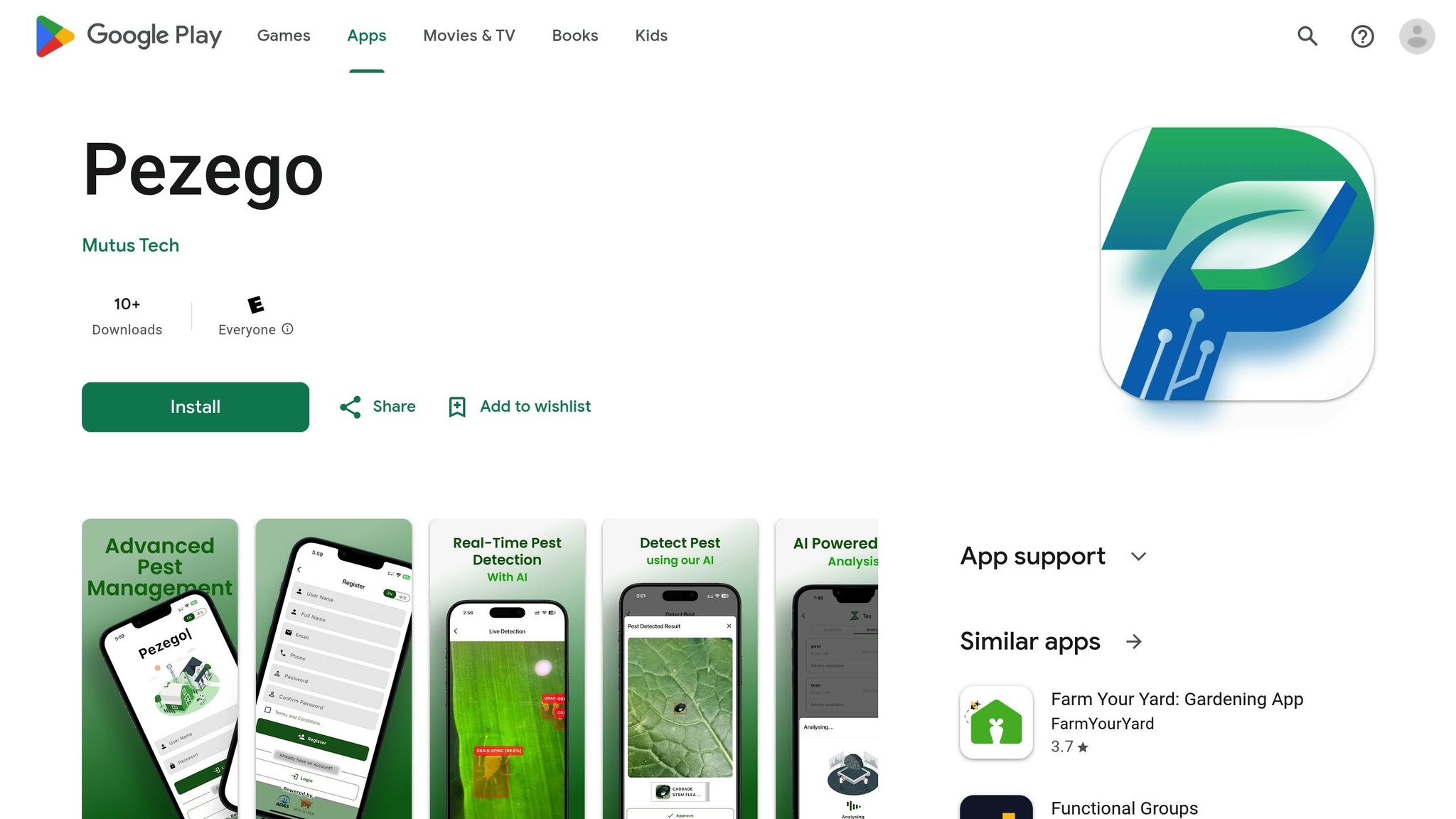
Pezego is a mobile-focused AI platform developed by Mutus Tech Ltd. It uses advanced image recognition and deep learning to provide instant pest identification right from your smartphone or tablet.
Real-time pest identification and monitoring
With Pezego, users can capture images of their crops or garden plants and receive instant pest alerts. The AI system identifies pests in detail, estimates their populations, and provides insights into infestation levels. This allows users to determine when action is necessary. Personalized notifications and an integrated analytics dashboard make it easy to track pest trends over time. Armed with this data, users can decide on timely biological or chemical interventions. By offering precise pest population estimates, Pezego simplifies the integration of control strategies, whether biological or chemical.
Supporting integrated pest management
Pezego plays a key role in integrated pest management (IPM) by delivering critical monitoring and identification data. Its detailed pest analysis helps users determine if biological controls are enough or if chemical solutions are required. This precision not only aids in immediate pest control but also supports the development of long-term IPM plans [2].
Adapting to regional and climate challenges
As climate change continues to impact pest behavior and distribution, adaptive management becomes more critical. Pezego addresses this by incorporating dynamic decision models that adjust to various environmental conditions.
"Pezego's models are designed to adjust dynamically to different climates, ensuring pest management recommendations remain effective across diverse environments." – Mutus Tech Ltd [2]
Reducing pesticide reliance
Pezego's accurate identification and pest quantification enable targeted interventions, cutting down on unnecessary pesticide use. This ensures pesticides are applied only when absolutely needed, protecting both the environment and human health. The platform aligns with IPM principles by emphasizing pesticide use only when monitoring confirms it as essential.
2. Precision Grow AI Pest Detection
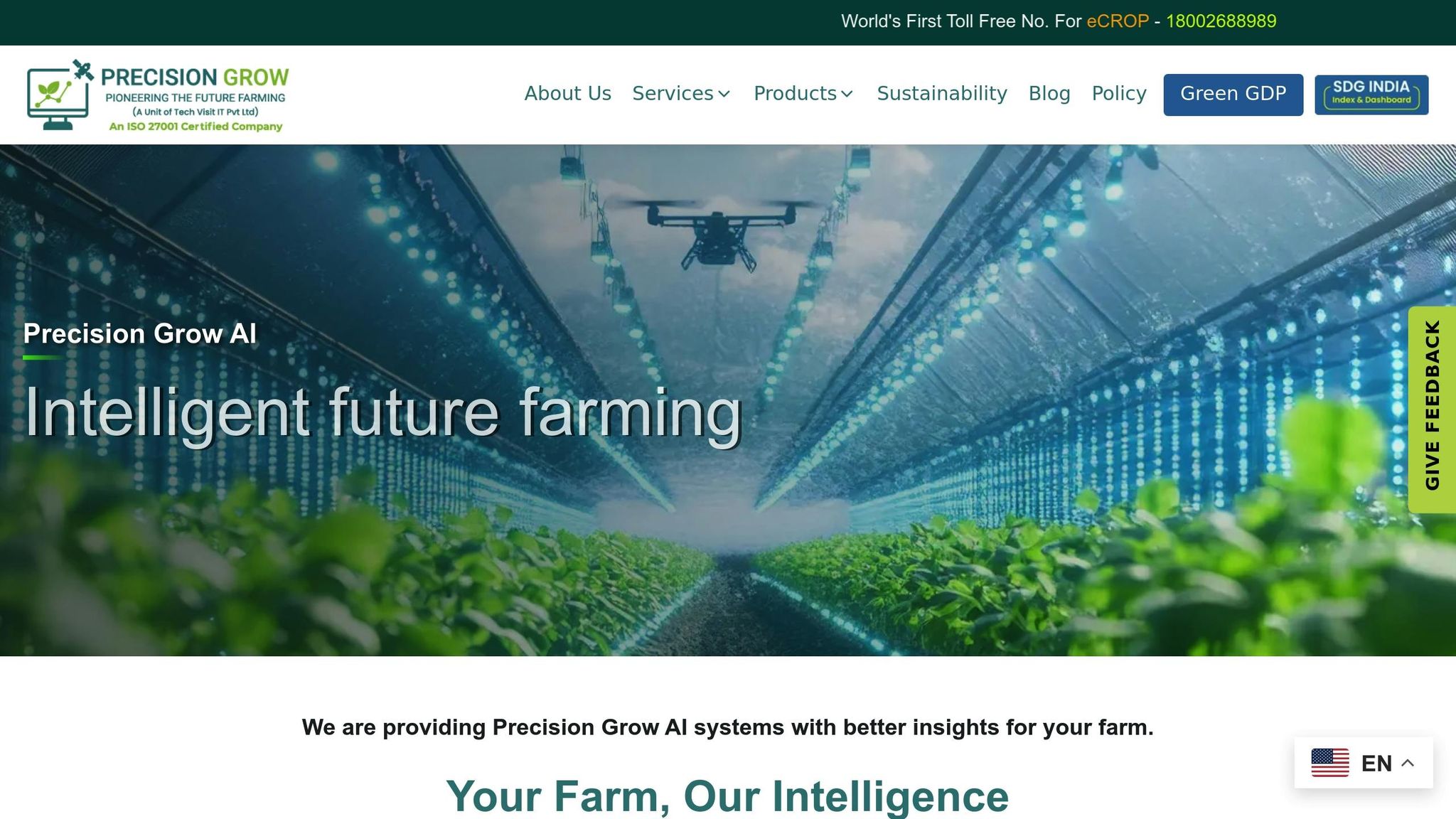
Precision Grow AI Pest Detection combines artificial intelligence (AI), remote sensing, and IoT technologies to deliver accurate and efficient pest monitoring. By analyzing a wealth of data - including sensor readings, satellite imagery, environmental conditions, and historical trends - it identifies and manages pest threats across farmlands with remarkable precision.
This advanced system enables real-time detection and swift action, redefining how pest issues are addressed.
Real-time Pest Identification and Monitoring
Using machine learning algorithms trained on extensive datasets of crop images and pest behavior, this system can differentiate between natural plant variations and actual pest-related problems. It leverages remote sensing tools like satellites, drones, and ground-based sensors equipped with multispectral and hyperspectral cameras to capture detailed images. Meanwhile, IoT devices - such as soil moisture sensors, humidity monitors, and temperature probes - continuously stream environmental data that influences pest activity.
What makes this technology stand out is its speed and accuracy. Traditional pest scouting methods often take 5–14 days and deliver only 70–75% accuracy. In contrast, Precision Grow AI identifies pests within the same day (0–1 days) with an accuracy rate of 92–97% [3]. It can monitor up to 100 acres per hour for early pest infestations, far surpassing manual inspections while reliably identifying over 90% of common pests [3].
Integration of Biological and Chemical Pest Control
Precision Grow AI aligns with Integrated Pest Management (IPM) principles by enabling targeted pest control strategies. Once pests are detected, the system supports precise biological and chemical interventions. Instead of broad-spectrum treatments, it pinpoints the exact location and type of pest, ensuring more efficient applications. AI-powered drones further enhance this process by delivering biological controls directly to infestation hotspots, promoting sustainable pest management [3].
Additionally, the system analyzes historical data and weather patterns to predict pest outbreaks. This allows farmers to plan interventions during the most vulnerable stages of a pest's lifecycle, improving the effectiveness of control measures [3].
Adapting to Regional and Climate Challenges
The platform’s AI algorithms continuously learn and adjust to varying environmental conditions, making it effective across diverse climates and regions. By integrating data from environmental sensors and weather forecasts, the system tailors its recommendations to local factors influencing pest behavior. Machine learning models trained on region-specific datasets ensure that pest management strategies remain effective, whether in arid deserts, humid coastal areas, or temperate farming zones.
Cutting Down Pesticide Use
One of the standout benefits of Precision Grow AI is its ability to reduce pesticide usage by up to 90% through precision spraying [3]. By accurately identifying pest locations and population densities, it eliminates the need for widespread chemical applications. Labor efficiency also improves significantly, with only 0.2 labor hours required per acre compared to the traditional 1.6–3.2 hours, while delivering potential yield increases of 15–25% or more [3]. These advancements not only reduce costs but also contribute to more sustainable pest control practices, benefiting both farmers and the environment in the long run.
🚀 Ready to Reinvent Your Garden?
Join thousands of homeowners who have transformed their gardens using our AI design tool. Upload one photo to explore endless possibilities.
Get your AI garden designs →3. AI-Powered Sensors and Smart Traps
AI-powered sensors and smart traps combine IoT devices, advanced cameras, and machine learning to instantly detect pests. These systems automatically identify pest species and send alerts whenever activity is detected.
Real-time Pest Identification and Monitoring
Today’s smart traps are equipped with sensor arrays that track heat, motion, and sound to identify pests. These devices monitor heat signatures, movement patterns, and sound frequencies, while cameras capture high-resolution images for AI analysis. This technology can differentiate between pest species with impressive precision, enabling targeted responses instead of broad-spectrum treatments.
"AI-powered monitoring provides instant detection, reducing the response time and preventing widespread infestations." [4]
Systems like Hygiene IQ and Trapview are leading the way in real-time monitoring. Hygiene IQ tracks rodent activity and sends alerts directly to technicians' mobile devices. Richard Adams, CEO and co-founder of Hygiene IQ, describes its impact:
"Hygiene IQ has improved our ability to respond to rodent issues... After installing our sensors in a problem area, we detected rodent activity quickly, allowing us to resolve the issue in less time than traditional methods." [7]
Meanwhile, Trapview focuses on agricultural pests with IoT-enabled insect traps designed for orchards and vineyards. These pheromone traps capture insects, take photographs, and use AI algorithms to predict pest spread patterns. This allows technicians to intervene with precise actions before infestations escalate [5].
By automating pest detection, these systems reduce the need for frequent manual checks while covering larger areas. Traditional inspections are often time-intensive and can miss early-stage infestations. With smart traps, early and accurate detection sets the stage for more effective biological and chemical interventions.
Integration of Biological and Chemical Pest Control
Smart sensor networks are a game-changer for Integrated Pest Management (IPM) strategies, providing the data needed to balance biological and chemical control methods. These systems analyze real-time conditions, pest population dynamics, and historical trends to recommend the best course of action for specific scenarios.
For example, cotton farmers have used AI pest detection systems alongside pheromone traps to manage bollworms. This combined approach helps farmers determine the ideal timing and amount of pesticide application, reducing overuse while protecting crops and improving yields [1].
A standout example is the SmartProbe, developed by UC Davis researcher Zhongli Pan. This technology monitors insect activity remotely and alerts storage facility managers to take action. It also tracks temperature and humidity levels to ensure optimal storage conditions. As Pan explains:
"The SmartProbe remotely monitors the activities of insects and alerts managers of storage and processing facilities to take proper actions for controlling the insects. It also monitors the temperature and relative humidity of stored products." [10]
Strategic placement of sensors - near doorways, windowsills, moisture-prone areas, and temperature-sensitive zones - enhances detection. Customizable sensitivity settings allow users to differentiate pest types while minimizing false alarms that could lead to unnecessary treatments [9].
Regional and Climate Adaptability
These systems don’t just detect pests - they adapt to local climates and conditions. Using continuous learning algorithms, AI-powered sensors adjust to regional environmental patterns and pest populations. By processing weather forecasts, historical infestation data, and real-time environmental metrics, they create location-specific pest management strategies.
For instance, Semios partnered with Google to develop predictive models tailored to regional agricultural needs. Their success in almond orchards highlights this adaptability: they used AI analysis to reduce a moth population by 1.5 billion insects, significantly boosting almond production [1].
These systems combine data on weather patterns, pest life cycles, and historical outbreaks to generate proactive models. This allows farmers and landscapers to prepare for potential infestations in advance, rather than reacting after the damage is done.
Reduction in Pesticide Use
Precision targeting and early intervention are key benefits of smart sensor technology, significantly reducing the need for broad-spectrum pesticide applications. By pinpointing pest locations and population densities, these systems minimize chemical use while maintaining crop protection.
AI detection systems boast 96% accuracy, with advanced DenseNet modeling achieving detection rates as high as 99.65% [10]. This level of precision helps prevent the estimated $220 billion in annual agricultural losses caused by pests and supports the 75% of global food crops that depend on animal pollination [6][8].
Additionally, these systems can monitor beneficial predatory insects, potentially cutting pesticide use by up to 50%. This supports natural biological controls and aligns with sustainable pest management practices, all while ensuring crops remain protected [8].
sbb-itb-4d6a8dd
4. AIGardenPlanner
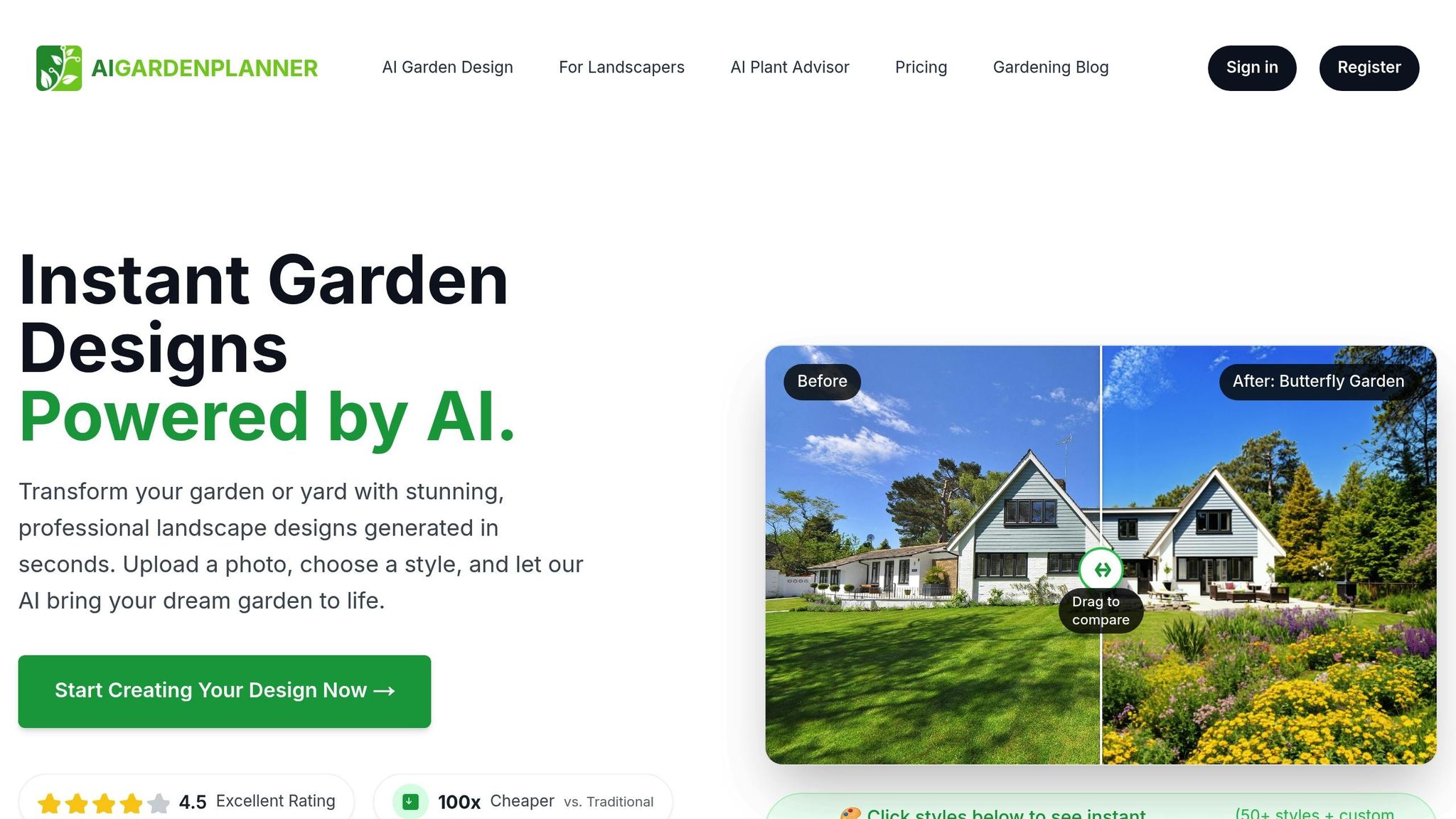
AIGardenPlanner has become a go-to tool across the United States for integrating AI-driven garden design with pest management strategies. By crafting location-specific landscapes, it naturally reduces pest pressure while offering garden visualization and plant recommendations tailored to local climates. This makes it a valuable ally in creating environmentally friendly pest control solutions.
Integrating Biological and Chemical Pest Control
AIGardenPlanner goes beyond just designing beautiful gardens - it actively helps create pest-resistant landscapes. Its AI Plant Advisor suggests plant combinations that not only enhance garden aesthetics but also reduce pest damage. By doing so, it supports the Integrated Pest Management (IPM) principle of minimizing risks to people, property, and the environment while keeping costs in check [11].
The platform provides recommendations for optimal plant layouts and companion planting to deter pests naturally. It considers your location and climate data to suggest pest-resistant plant varieties and companion crops that attract beneficial predators. Additionally, it offers step-by-step guides on pest management practices, including crop rotation and physical barriers, reducing the need for chemical treatments [12].
Adapting to Regional and Climate Needs
One of AIGardenPlanner's standout features is its ability to provide planting instructions customized to your specific region. The tool factors in plant growth patterns, seasonal shifts, and local conditions across the United States [13]. By combining advanced gardening knowledge with climate data, it creates realistic simulations for long-term landscape planning.
Users can rely on these AI-generated visualizations and local plant research to ensure their gardens thrive in their specific climate zones. The platform also addresses unique pest challenges that vary by region, reinforcing IPM’s focus on sustainable, long-term pest control.
Cutting Down on Pesticide Use
By aligning garden design with local climate data, AIGardenPlanner helps reduce the need for chemical treatments. It analyzes factors like crop health, pest activity, and environmental conditions to design gardens that naturally curb pest issues. This approach supports beneficial insects and predators, tackling the global challenge of pest-related losses, which account for 30 to 40 percent of crop damage annually, according to the FAO [5].
The platform also provides detailed maintenance schedules, helping users monitor plant health and apply targeted interventions only when absolutely necessary. This aligns with IPM’s principle of using chemical controls as a last resort, making AIGardenPlanner a practical tool for eco-conscious gardeners.
5. AgriSense AI Pest Management
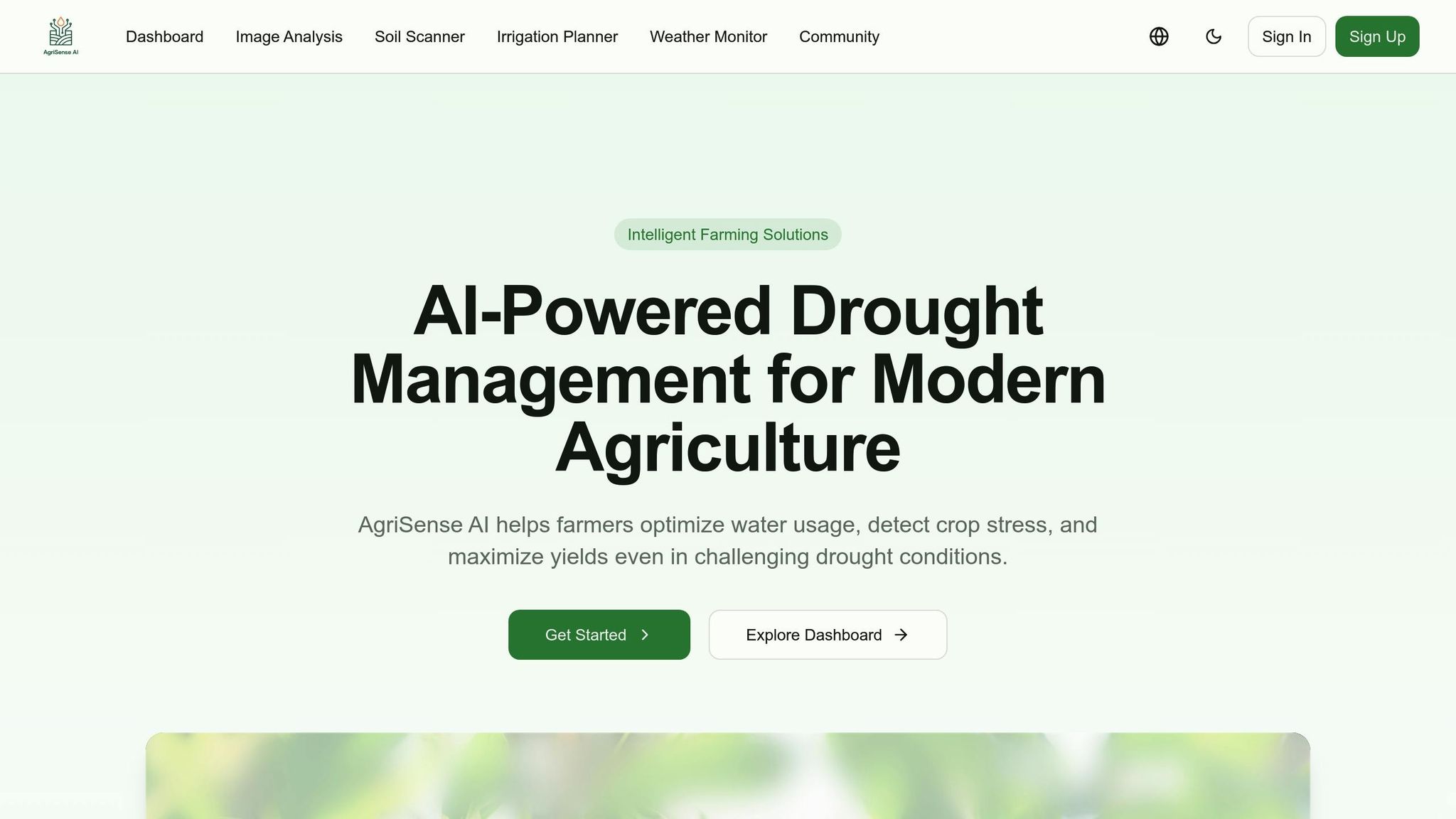
AgriSense AI takes pest management to the next level for U.S. gardens and farms by combining weather patterns, pest life cycles, and crop health data with advanced algorithms and sensor networks. Unlike traditional methods, this system uses autonomous, on-field data collection to provide a smarter, more integrated approach to pest control.
Real-time Pest Identification and Monitoring
With autonomous robots equipped with sensors, AgriSense tracks pest activity and identifies hotspots in real time. This allows for precise, targeted interventions instead of blanket treatments, making pest control more efficient and less invasive.
The system also incorporates IoT-enabled traps similar to EFOS Ltd.'s Trapview. These smart traps, equipped with cameras and sensors, monitor pest populations in locations like orchards and vineyards. AI algorithms then analyze the data to determine when and where action is needed [14].
Integration of Biological and Chemical Pest Control
AgriSense blends biological and chemical pest control methods through data-driven insights. It carefully monitors pest activity alongside beneficial insect populations, offering recommendations that ensure treatments are applied only when necessary. This balance ensures that biological controls are prioritized, with chemical interventions used strategically when they’re most effective.
Adapting to Regional and Climate Challenges
As climate change accelerates pest reproduction and alters their behavior, AgriSense stays ahead by continuously updating its recommendations using real-time local climate and soil data [15]. This allows the system to set precise treatment thresholds, ensuring pest control measures are applied only when conditions demand it. By tailoring its approach to evolving environmental factors, AgriSense reinforces Integrated Pest Management (IPM) practices.
"Our AI-driven models adjust pest management recommendations to real-time environmental data, including climate and soil conditions. This enables farmers to apply targeted, sustainable pest control tailored to their specific field conditions." - Mutus Tech Ltd [2]
Reducing Pesticide Use
One of AgriSense’s standout achievements is its ability to significantly cut down on chemical pesticide use. For example, its AI-powered weed detection and spot-spraying technology has reduced herbicide application by up to 90% in some field trials [14]. By focusing only on affected areas, the system limits chemical exposure while maintaining effective crop protection.
This precision approach also supports long-term sustainability. It encourages the growth of beneficial insect populations and promotes healthier soil, which aligns perfectly with the increasing demand for organic produce. The organic market is expected to hit $40 billion in the U.S. by 2030 [15].
Feature Comparison Table
Selecting the ideal AI pest management tool hinges on your specific needs, budget, and the scope of your gardening or farming operation. Each platform brings unique strengths to the table - from real-time monitoring to predictive analytics - while catering to different operational demands and regional factors.
Here's a quick comparison to help U.S. gardeners and farmers make an informed decision:
| Tool | Primary Strengths | Pest Detection Accuracy | Coverage Area | Integration Capabilities | Cost Considerations | Best For |
|---|---|---|---|---|---|---|
| Pezego | Real-time monitoring, mobile alerts | 85–90% | Up to 500 acres | Weather data, IoT sensors | $2,000–$5,000 setup | Commercial farms |
| Precision Grow AI | Predictive modeling, early warnings | 92–97% | Virtually unlimited | Satellite imagery, drones | $50–$200/month | Mid to large-scale farms |
| Smart Traps & Sensors | 24/7 monitoring | 88–93% | 50–100 acres per unit | Mobile apps, real-time analytics | $500–$1,500 per trap | Orchards, vineyards |
| AIGardenPlanner | Garden design integration, plant advice | N/A (design-focused) | Residential gardens | Climate data, location-based tips | $9–$42/month | Home gardeners, landscapers |
| AgriSense AI | Autonomous robots, precision spraying | 90–95% | 200–1,000 acres | Weather, soil sensors, IoT | $10,000–$25,000 | Large commercial farms |
Each tool plays a vital role in advancing Integrated Pest Management (IPM) strategies, whether for home or commercial use.
Detection Speed and Response Time
AI tools drastically reduce detection times, identifying pest issues within hours compared to the 5–14 days required for traditional scouting. For example, Precision Grow AI excels with same-day detection, boasting accuracy rates as high as 97% [3].
Regional Compatibility
Effectiveness varies across U.S. regions due to factors like climate, pest species, and local farming practices. Tools with precision spraying technology have shown impressive results, cutting pesticide use by up to 90% in field tests [3]. This adaptability supports efficient pest management across diverse conditions.
Resource Efficiency
AI-driven pest detection slashes labor needs, requiring less than 0.5 hours per acre compared to 4–8 hours for manual scouting. This efficiency can boost yields by up to 25%, significantly reducing labor costs.
Chemical Reduction Capabilities
These systems can cut pesticide usage by 80% or more compared to traditional methods [17]. For instance, California vineyards using AI-powered drones have pinpointed pest infestations early, enabling targeted treatments that preserve crop quality while minimizing chemical use [16].
Sustainability Impact
AI pest management aligns with environmentally conscious IPM principles. These tools often achieve high eco-friendliness scores (4–5 out of 5), thanks to precise targeting and reduced chemical application. Traditional methods, by contrast, score around 2 [3].
Ultimately, the right choice depends on your operation's scale and priorities. Home gardeners may find AIGardenPlanner's design and plant selection features most useful, while larger commercial farms benefit from the advanced monitoring and autonomous capabilities of tools like AgriSense AI or Precision Grow AI.
🎨 Visualize Your Dream Garden Today!
Transform any outdoor space into a professional landscape design in minutes. Just upload a photo, choose your style, and let our AI do the rest.
Start your garden transformation now →Conclusion
AI-powered pest management is changing the game by shifting pest control from a reactive chore to a proactive strategy for healthier gardens and landscapes. These tools bring a level of precision that traditional methods struggle to achieve, with detection accuracy soaring between 92% and 97% compared to conventional scouting techniques [3].
One standout advantage is the ability of AI systems to cut pesticide use by as much as 90%. By focusing on targeted applications, these tools significantly reduce reliance on chemicals while still maintaining effective pest control [3]. The result? Healthier soil, cleaner water, and safer habitats for beneficial insects and wildlife.
The economic and operational benefits are just as impressive. Properties using AI for pest management report a 20% improvement in overall health and a 25% drop in maintenance costs [18]. In India, a study showed that AI-driven pest management slashed pesticide expenses by 30% and boosted crop productivity by 20% [16]. Traditional scouting methods can take up to 14 days and require 1.6–3.2 labor hours per acre. In contrast, AI systems offer same-day detection, cutting labor time down to just 0.2 hours per acre [3]. This quick turnaround prevents minor pest issues from spiraling into major infestations.
Another key strength of AI is its ability to integrate biological and chemical strategies seamlessly. By analyzing factors like weather patterns, pest life cycles, and local environmental conditions, these systems pinpoint the best timing and methods for interventions. Whether it's releasing beneficial insects or applying precision treatments, AI ensures every action aligns with the broader goal of maintaining ecosystem balance.
Take AIGardenPlanner, for example. This platform combines garden design with pest management, offering home gardeners tools to create pest-resistant, climate-adapted landscapes. Its plant recommendations are tailored to local climates, while its design features encourage proper spacing and companion planting - both of which support beneficial insects and natural pest control.
As technology in this field continues to evolve, AI tools are proving their worth to gardeners and farmers alike, expanding their applications and impact.
FAQs
How do AI tools like Pezego and Precision Grow AI help reduce pesticide use in Integrated Pest Management (IPM)?
AI tools like Pezego and Precision Grow AI are transforming how we manage pests, particularly within Integrated Pest Management (IPM) systems. Pezego uses real-time pest identification and data analysis to focus treatments where they’re needed most. This means fewer broad chemical applications, which not only cuts down on pesticide use but also aligns with environmentally conscious pest management practices.
On the other hand, Precision Grow AI brings advanced pest monitoring and forecasting into the mix. By pinpointing exactly where pesticides should be applied, it helps reduce chemical use dramatically. This approach not only safeguards crops but also minimizes environmental impact, making pest control more efficient and eco-conscious. Together, these tools are reshaping pest management for the better.
What should I consider when selecting an AI tool for pest management on small gardens, farms, or large agricultural operations?
When picking an AI tool for pest management, it's essential to weigh cost, ease of use, and scalability to ensure it fits your specific requirements. For large-scale farms, investing in advanced tools with features like high-precision sensors and the ability to process massive amounts of data can be a smart move. These tools are designed to efficiently handle vast areas, making them a valuable choice for bigger operations.
On the other hand, smaller farms often benefit more from budget-friendly, straightforward solutions that don’t demand extensive infrastructure or technical know-how.
Scalability is another crucial factor. Large farms need systems that can handle extensive datasets and adapt to evolving conditions, while smaller setups might focus on simpler tools that deliver clear, actionable insights without unnecessary complexity. In the end, the best tool will align with your budget, technical capabilities, and the specific scale of your pest management needs.
How do AI-powered sensors and smart traps adjust to different climates and regions for better pest management?
AI-powered sensors and smart traps rely on real-time data and machine learning to adjust to different climates and regions. These tools analyze factors such as temperature, humidity, and pest behavior to refine their detection and control methods based on the specific environment.
By tailoring their approach, they can tackle pests more precisely, reduce the need for pesticides, and improve pest management in a variety of conditions - whether it's a scorching, arid landscape or a cooler, moisture-heavy setting. This leads to a more efficient and eco-friendly way of safeguarding gardens and landscapes.
Related posts
Related Articles

Effective Methods to Control White Butterflies in Your Garden
Learn how to deter white butterflies from damaging your garden with natural and preventive measures. Discover ways to protect your plants from these common pests.

Imaging Techniques for Non-Destructive Disease Detection
Explore advanced imaging techniques revolutionizing non-destructive plant disease detection, enhancing early diagnosis and crop management.
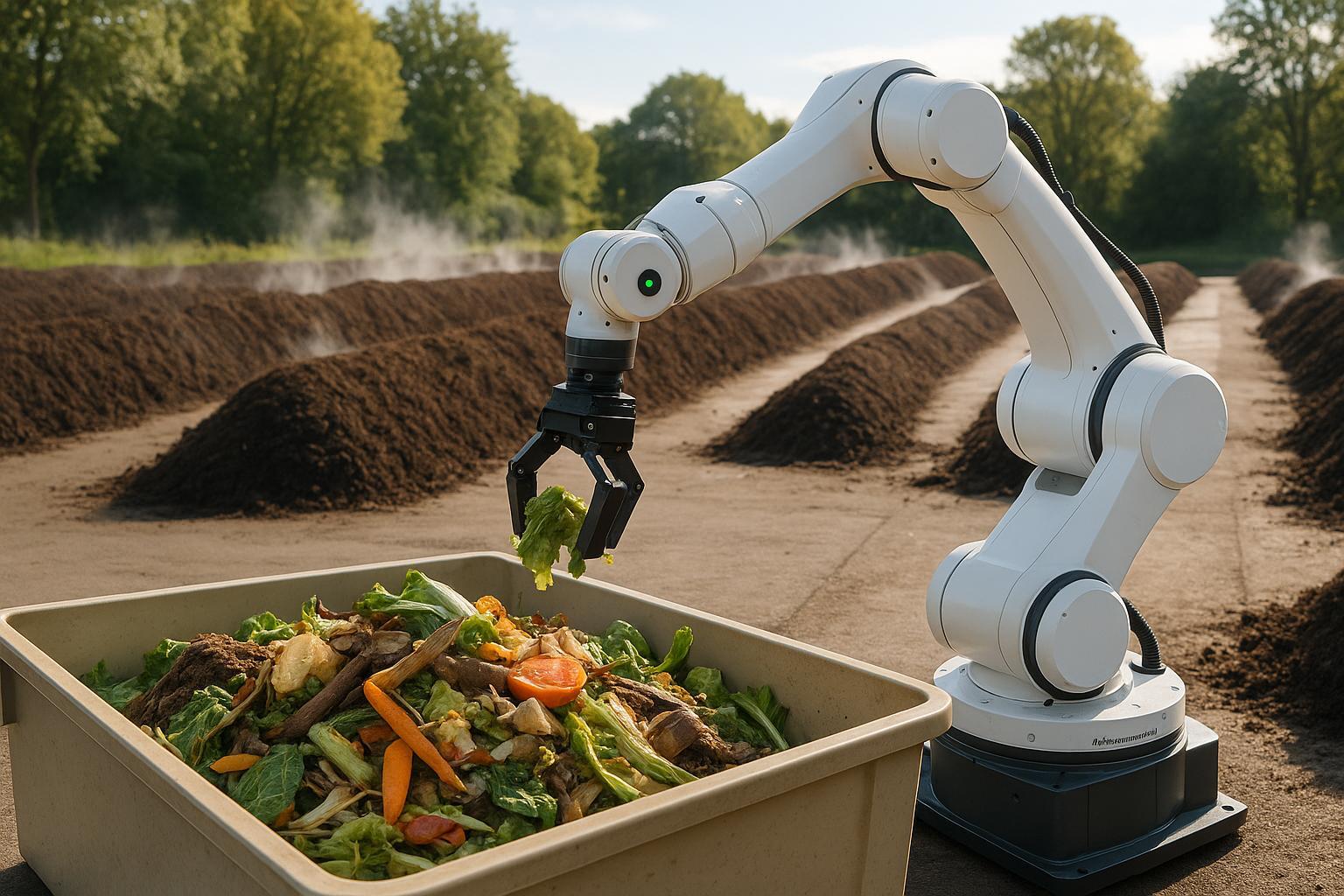
AI in Composting: Emission Control Insights
Explore how AI is revolutionizing composting by reducing emissions, enhancing sorting accuracy, and improving overall efficiency.
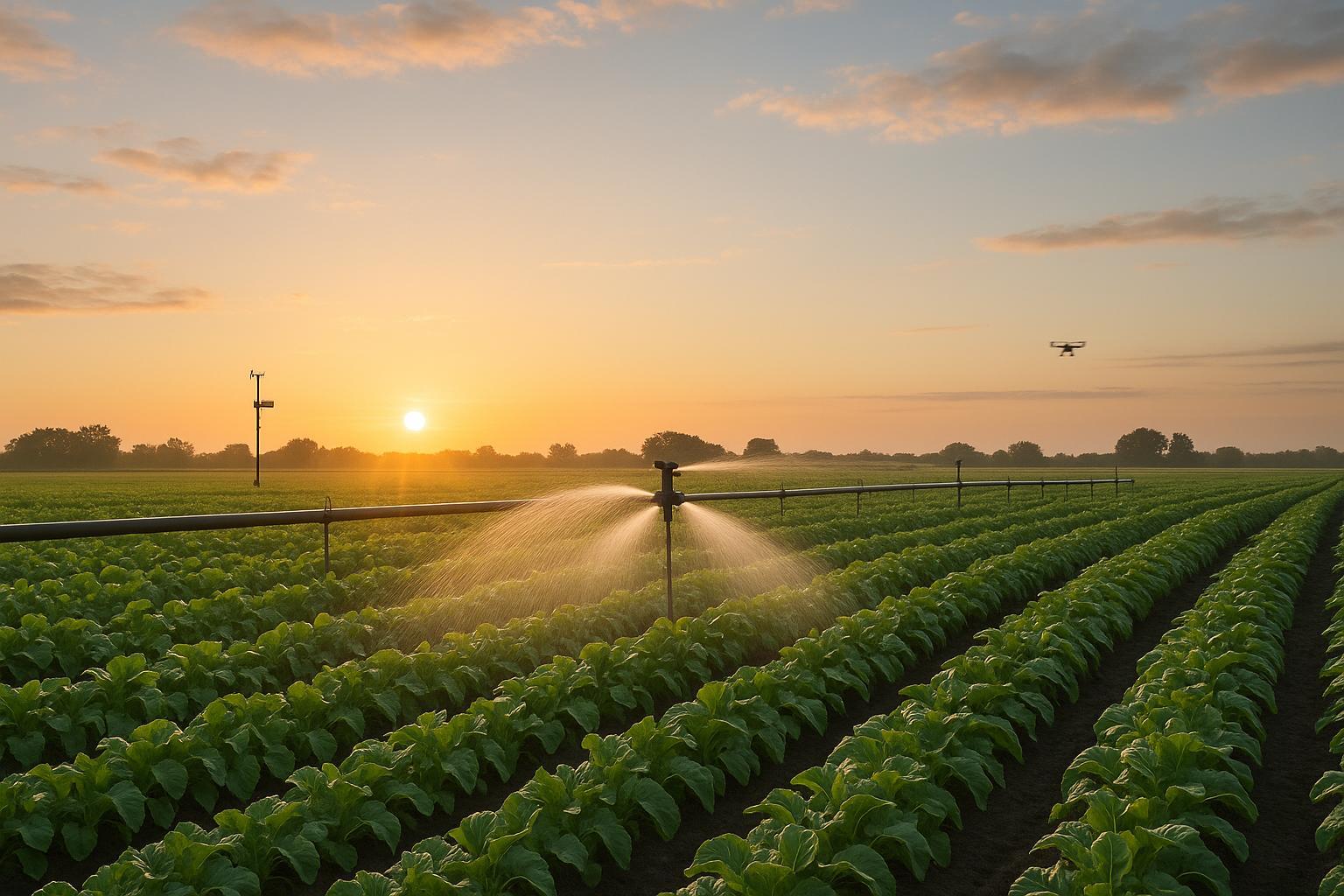
How AI Predicts Weather for Smarter Irrigation
Explore how AI-driven weather predictions optimize irrigation systems, enhancing water efficiency, crop yields, and cost savings for farmers.
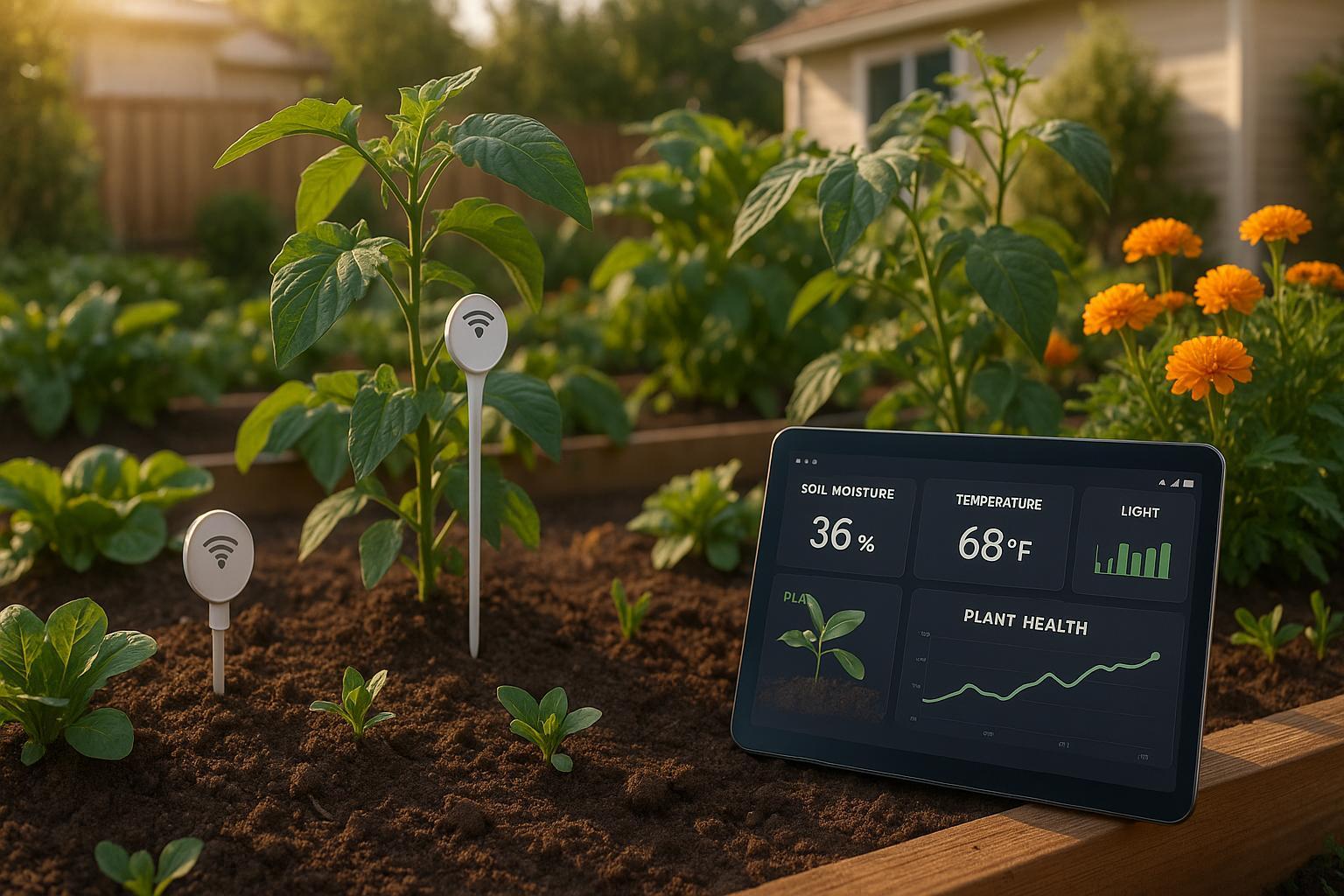
IoT Data Collection for Climate-Specific Gardening
Explore how IoT technology revolutionizes gardening by optimizing resource use, predicting diseases, and enhancing plant health for sustainable practices.
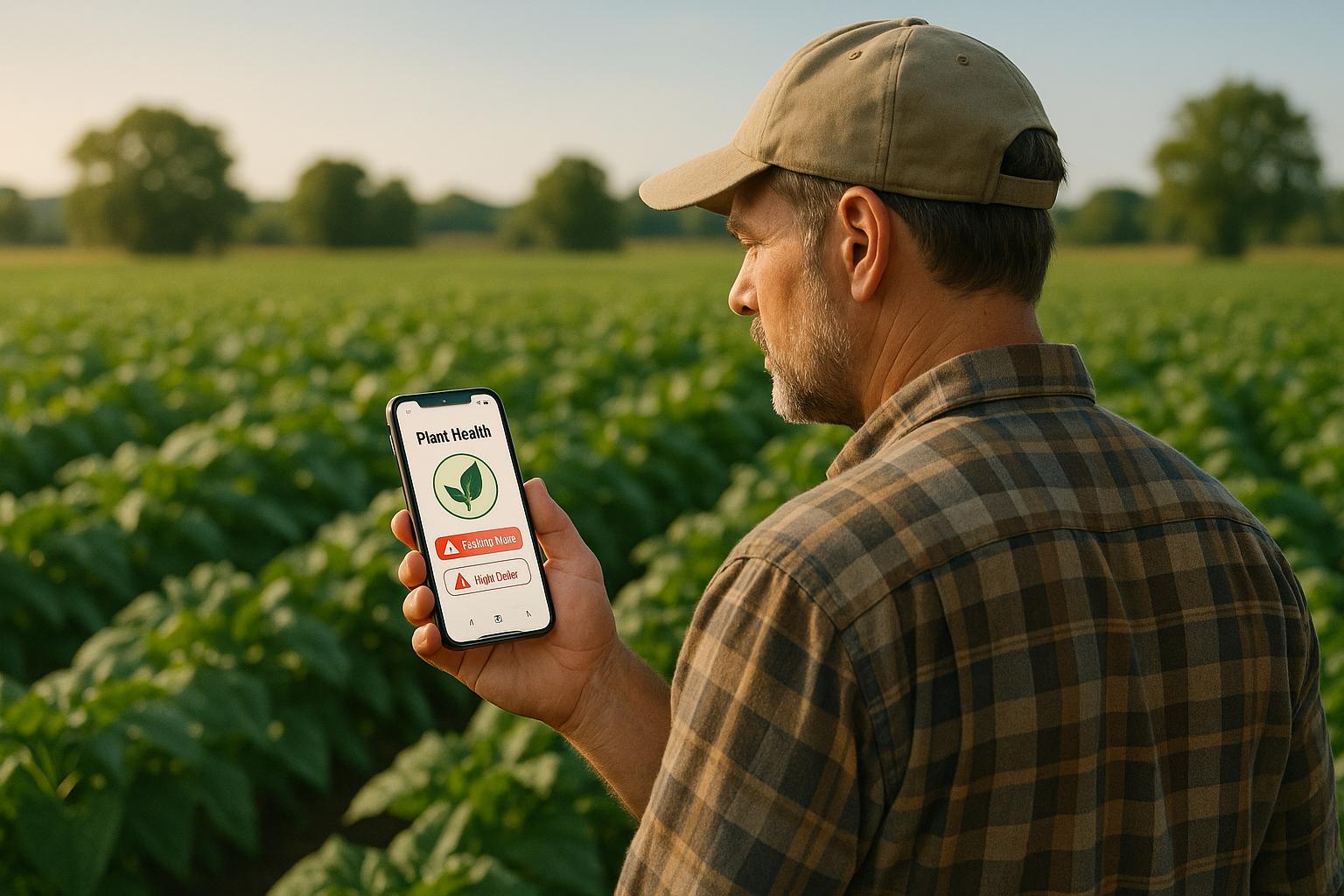
How Mobile Alerts Help Prevent Plant Disease Spread
Mobile alert systems revolutionize plant disease prevention by providing real-time monitoring and tailored alerts for gardeners and farmers.